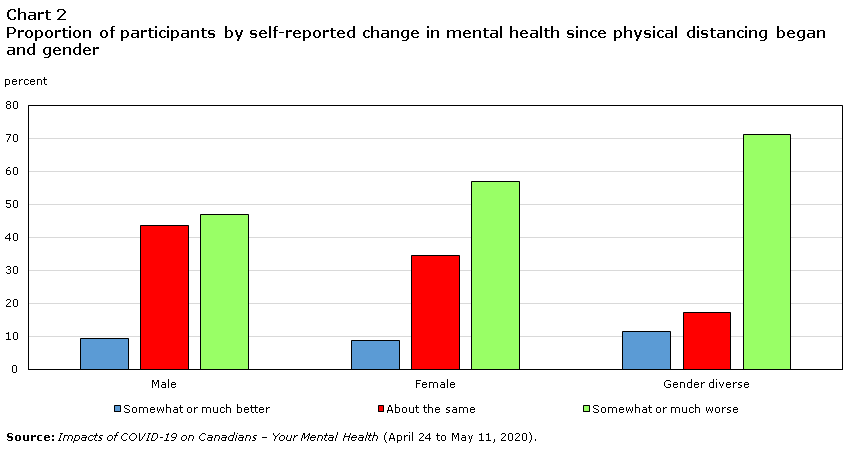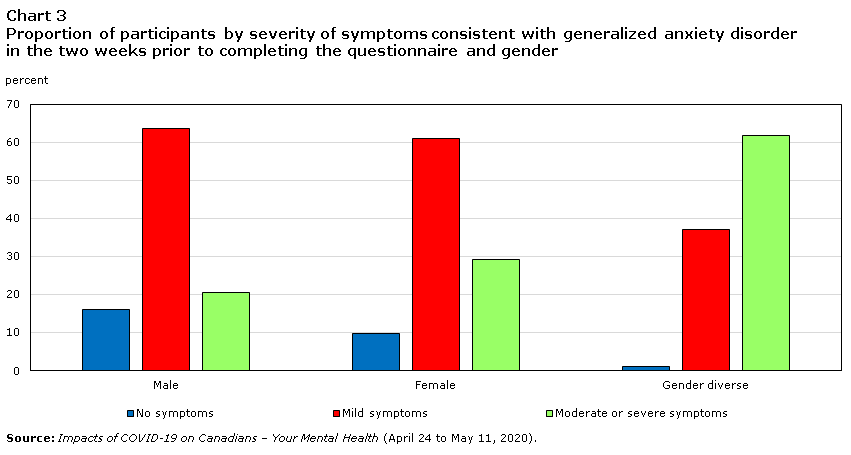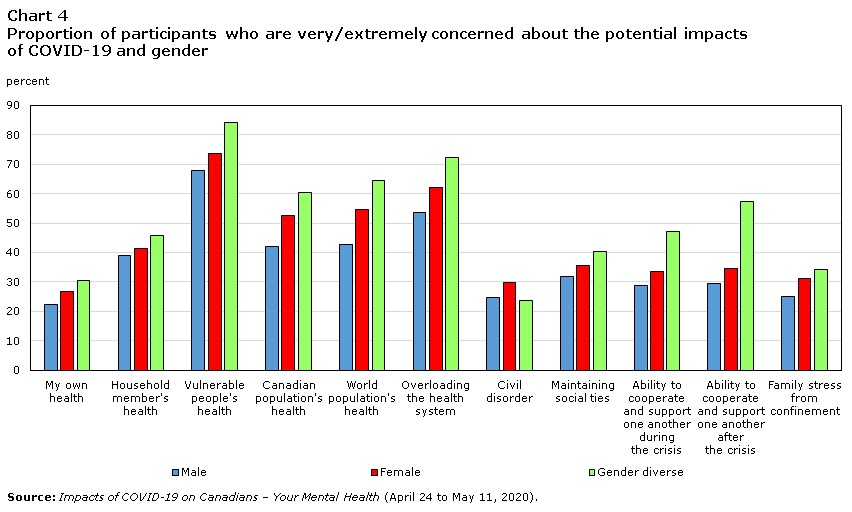 StatCan COVID-19: Data to Insights for a Better CanadaGender differences in mental health during the COVID-19 pandemic
StatCan COVID-19: Data to Insights for a Better CanadaGender differences in mental health during the COVID-19 pandemic
Archived Content
Information identified as archived is provided for reference, research or recordkeeping purposes. It is not subject to the Government of Canada Web Standards and has not been altered or updated since it was archived. Please "contact us" to request a format other than those available.
Start of text box

This article provides disaggregated data to better understand the impact of COVID-19 on specific groups. Visit the Gender, Diversity and Inclusion Statistics Hub for more analysis, including disaggregated data on labour, public safety, health and more.
End of text box
The COVID-19 pandemic and the associated public-health measures restricting movement and limiting physical contact with others have significantly altered the daily routines of Canadians. Adapting to lifestyle changes such as working from home, temporary job loss or reduced work hours, home-schooling children, and social isolation is challenging, particularly during a time wrought with fear, uncertainty, and stress. For this reason, the United Nations recently warned that a global mental health crisis is looming (Kelland 2020).
Using data collected through a crowdsource questionnaire from April 24 to May 11, 2020, this article compares the mental health of male, female, and gender-diverse participants during the COVID-19 pandemic. Four different measures of mental health are considered: self-rated mental health, changes in mental health since physical distancing began, symptoms consistent with generalized anxiety disorder in the two weeks prior to completing the questionnaire, and life stress.
Readers should note that, unlike other surveys conducted by Statistics Canada, crowdsourced data are not collected according to a probabilistic sampling design. Therefore, when interpreting findings from these data, no inferences should be made about the Canadian population.
Female participants more likely than males to report worse mental health since physical distancing began
Female crowdsource participants reported lower levels of mental health during the COVID-19 pandemic than male participants across all measures. One quarter (25.5%) of female participants reported “fair” or “poor” mental health during the COVID-19 pandemic, compared with 21.2% of male participants (Chart 1). These results are consistent with those from Statistics Canada’s probabilistic web panel survey, “Canadian Perspectives Survey Series 2: Monitoring the Effects of COVID-19,” where 24.9% of women and 19.0% of men reported fair/poor mental health.

Data table for Chart 1
| Male | Female | Gender diverse | |
|---|---|---|---|
| percent | |||
| Fair or poor | 21.2 | 25.5 | 67.7 |
| Good | 27.7 | 33.7 | 23.5 |
| Very good or excellent | 51.2 | 40.8 | 8.8 |
| Source: Impacts of COVID-19 on Canadians – Your Mental Health (April 24 to May 11, 2020). | |||
Prior to the COVID-19 pandemic, women were more likely than men to report fair/poor mental health (8.6% vs. 6.7%), according to data from the 2018 Canadian Community Health Survey (CCHS). While results of the crowdsource are not comparable to the CCHS, they do signal that, for both female and male participants, the pandemic appears to be having an impact on mental health, as 57.0% of female participants in the crowdsource reported their mental health is “somewhat” or “much” worse since physical distancing began, as did 47.0% of male participants (Chart 2).

Data table for Chart 2
| Male | Female | Gender diverse | |
|---|---|---|---|
| percent | |||
| Somewhat or much better | 9.3 | 8.6 | 11.6 |
| About the same | 43.7 | 34.4 | 17.3 |
| Somewhat or much worse | 47.0 | 57.0 | 71.1 |
| Source: Impacts of COVID-19 on Canadians – Your Mental Health (April 24 to May 11, 2020). | |||
Female participants more likely than males to report symptoms consistent with moderate/severe generalized anxiety disorder
In terms of mental health, the COVID-19 pandemic can be experienced in many different ways, including feelings of depression, grief, fear, panic, and anxiety—all of which can be normal responses to situations where daily routines are disrupted and circumstances are uncertain and perceived as potentially risky. Because anxiety is one of the most common reactions to such situations, the crowdsource questionnaire asked participants about symptoms consistent with generalized anxiety disorder (GAD). GAD is a condition characterized by a pattern of frequent, persistent worry and excessive anxiety about several events or activities.
A larger proportion of female participants than male participants reported symptoms consistent with "moderate" or "severe" GAD in the two weeks prior to completing the crowdsource questionnaire: 29.3% vs. 20.5% (Chart 3). These results are consistent with those from Statistics Canada’s probabilistic web panel survey, “Canadian Perspectives Survey Series 2: Monitoring the Effects of COVID-19,” where 20.8% of women and 15.4% of men reported symptoms consistent with moderate/severe GAD.

Data table for Chart 3
| Male | Female | Gender diverse | |
|---|---|---|---|
| percent | |||
| No symptoms | 16.0 | 9.7 | 1.1 |
| Mild symptoms | 63.6 | 61.0 | 37.1 |
| Moderate or severe symptoms | 20.5 | 29.3 | 61.8 |
| Source: Impacts of COVID-19 on Canadians – Your Mental Health (April 24 to May 11, 2020). | |||
Previous (pre-pandemic) population health surveys indicate that women report higher levels of anxiety than men (Statistics Canada 2020b).
That female participants were more likely than male participants to report symptoms consistent with moderate/severe GAD during the pandemic may reflect gender differences in concerns about the potential impacts of COVID-19. While female and male participants had the same pattern of concerns about the potential impacts of COVID-19 (with “vulnerable people’s health,” “overloading the health system,” and “the world population’s health” being cited most often by both groups), female participants were consistently more likely than male participants to be “very” or “extremely” concerned about these impacts (Chart 4).

Data table for Chart 4
| Male | Female | Gender diverse | |
|---|---|---|---|
| percent | |||
| My own health | 22.5 | 26.9 | 30.5 |
| Household member's health | 38.9 | 41.4 | 45.7 |
| Vulnerable people's health | 67.9 | 73.6 | 84.2 |
| Canadian population's health | 41.9 | 52.6 | 60.5 |
| World population's health | 42.6 | 54.5 | 64.6 |
| Overloading the health system | 53.5 | 62.2 | 72.3 |
| Civil disorder | 24.6 | 29.9 | 23.8 |
| Maintaining social ties | 31.8 | 35.5 | 40.2 |
| Ability to cooperate and support one another during the crisis | 28.9 | 33.6 | 47.1 |
| Ability to cooperate and support one another after the crisis | 29.5 | 34.6 | 57.2 |
| Family stress from confinement | 25.0 | 31.3 | 34.1 |
| Source: Impacts of COVID-19 on Canadians – Your Mental Health (April 24 to May 11, 2020). | |||
Female participants more likely than males to report that their lives are quite a bit/extremely stressful
A greater proportion of female participants than male participants reported that their lives were “quite a bit” or “extremely” stressful during the COVID-19 pandemic: 30.5% vs. 24.0%. Results from the 2018 CCHS indicate a similar pattern, where 22.9% of women and 19.1% of men reported that their lives were quite a bit/extremely stressful. While crowdsourced data are not directly comparable with population estimates from a sample survey like the CCHS, they are suggestive of an increase in life stress among both women and men during the COVID-19 pandemic.
Although the crowdsource did not collect information on marital status, the presence of children, or time use, it may be the case that some female participants reported higher levels of life stress than male participants because the quarantine has exacerbated the gender division of unpaid family work (i.e., caring for children and housework) within households. Data from the 2015 General Social Survey on Time Use show that women spent more time, on average, than men on caregiving for children (3.5 vs. 2.1 hours per week) and unpaid household chores (16.8 vs. 11.9 hours per week). With the closure of daycares, schools, and businesses like restaurants and drycleaners, women may be doing unpaid family work that their households would have previously outsourced to the paid economy, or with which their households would have previously received help from extended family or friends.
Gender-diverse participants have poorer mental health outcomes than both female and male participants
By all measures, gender-diverse crowdsource participants—that is, participants who did not report their current gender as exclusively female or male—reported poorer mental health during the COVID-19 pandemic than both female and male participants. This gap was most pronounced for self-rated mental health during the pandemic and symptoms of generalized anxiety disorder in the two weeks prior to completing the questionnaire.
Almost 70% of gender-diverse participants reported fair/poor mental health, compared with 25.5% of female participants and 21.2% of male participants. The proportion of gender-diverse participants who reported symptoms consistent with moderate/severe GAD was double (61.8%) that of female participants (29.3%) and triple that of male participants (20.5%).
The greater vulnerability of gender-diverse participants to poorer mental health outcomes during the COVID-19 pandemic may partially reflect their age. Previous research demonstrates that the mental health of younger Canadians has been particularly affected by the pandemic and quarantine (Findlay & Arim 2020; Statistics Canada 2020 a & b). More than half of gender-diverse participants (54.7%) were under the age of 30, compared with 21.6% of female participants and 20.7% of male participants.
Gender-diverse participants were also more likely than both female and male participants to be very/extremely concerned about the potential impacts of COVID-19 (with the exception of civil disorder), which may contribute to their poorer mental health outcomes (Chart 4).
Other factors that may predispose gender-diverse participants to poorer mental health outcomes during the COVID-19 pandemic, compared with female and male participants, are their greater likelihood of job loss and inadequate financial resources. Gender-diverse participants (13.9%) were somewhat more likely than female and male participants (10.6% and 12.5%, respectively) to "agree" or "strongly agree" that they might lose their main job or main source of self-employment income in the next four weeks. Gender-diverse participants were also more likely to report that they had in fact lost their job or business in the last four weeks (14.6% vs. 8.6% and 7.7%, respectively).
Consistent with this finding, a greater proportion of gender-diverse participants (39.5%) than female and male participants (23.5% and 23.8%, respectively) reported that COVID-19 has had a “moderate” or “major” impact on their ability to meet their financial obligations or essential needs, such as rent or mortgage payments, utilities, and groceries.
Methodology
This article examined gender differences in the self-perceived mental health of Canadians during the COVID-19 pandemic. To do so, data collected through Statistics Canada’s crowdsource questionnaire, “Impacts of COVID-19 on Canadians – Your mental health,” were analyzed. This questionnaire was live on Statistics Canada’s website between April 24 and May 11, 2020, and around 46,000 residents of Canada completed it voluntarily.
It is important to note that statistical inferences about the Canadian population cannot be made from participants in crowdsource questionnaires, as the respondents are self-selected. Respondents to traditional sample-based surveys, on the other hand, are probabilistically selected from the target population. Nevertheless, crowdsourcing is a cost-effective and timely way to collect granular data on a particular topic.
In this article, methodological adjustments were made to account for age, sex, and provincial differences.
Physical distancing was defined as making changes in everyday routines in order to minimize close contact with others, including: avoiding crowded places and gatherings, avoiding common greetings, such as handshakes, limiting contact with people at higher risk, and keeping a distance of at least two arms’ length from others (approximately two meters).
As per Statistics Canada’s gender classification, gender-diverse participants were defined as those persons who did not report their current gender as exclusively male or female. It included persons who reported being unsure of their gender, as well as persons who reported being both male and female or neither male nor female. Importantly, the male and female genders included cisgender (those for whom their sex assigned at birth and current gender align) and transgender persons who reported their current gender as being male or female, respectively.
Anxiety was measured using the GAD-7 scale, which is used in population health surveys to identify probable cases of generalized anxiety disorder (GAD) as well as to measure the severity of anxiety symptoms. GAD is a condition characterized by a pattern of frequent, persistent worry and excessive anxiety about several events or activities. Those with a score of 10 or higher on the GAD-7 were considered to have moderate to severe symptoms of generalized anxiety disorder in the two weeks prior to completing the survey. The data reported do not necessarily reflect a professional diagnosis of GAD. In the context of the COVID-19 outbreak where the population has been unexpectedly exposed to an unprecedented global crisis with wide-ranging impacts including significant disruption to employment, schooling, and routines, and increased health risk, it is important to note that feelings of anxiety can be understood as natural reactions and not necessarily indicators of a long-term mental health disorder.
Statistics Canada is committed to monitoring the impacts of COVID-19 on Canadians. We will continue to do so in the coming weeks through crowdsource surveys and web panels.
References
Findlay, Leanne and Rubab Arim. 2020. “Canadians report lower self-perceived mental health during the COVID-19 pandemic.” StatCan COVID-19: Data to Insights for a Better Canada, catalogue no. 45-28-0001. Ottawa: Statistics Canada.
Kelland, Kate. 2020. “UN warns of global mental health crisis due to COVID-19 pandemic.” World Economic Forum. National Post (May 13).
Statistics Canada. 2020a. “Canadians’ mental health during the COVID-19 pandemic.” The Daily (May 27).
Statistics Canada. 2020b. “Canadian Perspectives Survey Series 2: Monitoring the effects of COVID-19, May 2020.” The Daily (June 4).
- Date modified:
